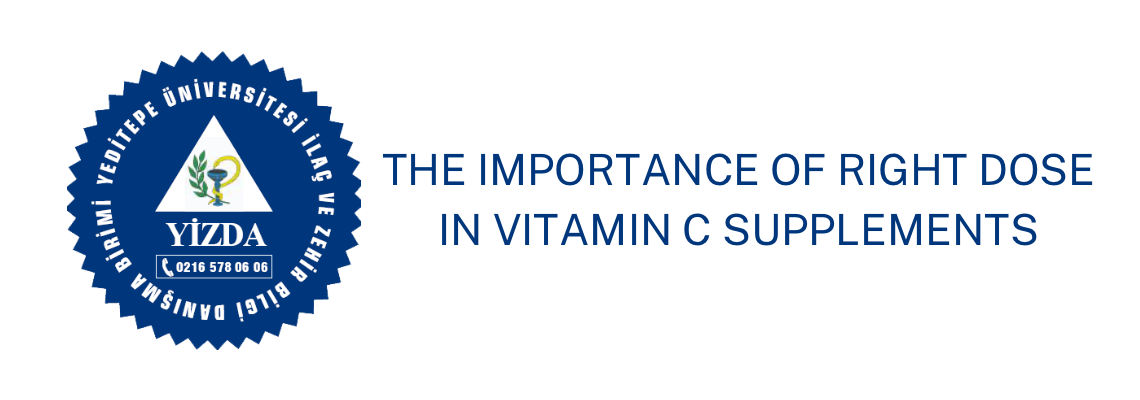
Vitamin C, a powerful antioxidant; plays a critical role in the biosynthesis of collagen, which is of great importance in tissue regeneration and wound healing.1,2 In addition, it works with glutathione to regenerate the vitamin E that has been used in the body.3 It is also involved in the biosynthesis of carnitine and some hormones and the absorption and storage of iron.4 Vitamin C, also known as ascorbic acid, cannot be synthesized in the human body and since it is a water-soluble vitamin, it is not stored, so it should be taken daily from external sources.1 The recommended daily dose (RDA) is 90 mg for adult men and 75 mg for women.1,4
There are fruits and vegetables rich in vitamin C that grow in the soils of Turkey.4 For example, raw carrots contain 3 mg, tomatoes contain 15 mg, oranges contain 45 mg, and lemons contain 30 mg of vitamin C in every 100 grams.6-9-8 In addition to these fruits and vegetables, red and green peppers, kiwi, broccoli, strawberries, Brussels sprouts are also rich in vitamin C.1,7 However, most foods lose their Ascorbic acid content during storage or cooking as it can rapidly deteriorate with heat..10
Vitamin C deficiency causes fatigue, joint pain, difficulty in wound healing, gum diseases and in severe cases, scurvy.1,4 Although the deficiency of this vitamin is rare, the need for vitamin C may increase due to environmental pollution, smoking or alcohol use, pregnancy and chronic diseases so especially people in the risk group should pay attention to adequate and balanced nutrition.11 The recommended daily dose can be achieved easily by consuming 5 fruit or vegetable rich in vitamin C. 9 However, the use of supplements containing vitamin C becomes important when it is not adequately taken with foods. These supplements are available in the market mostly in ester or salt form and in doses varying up to 1000 mg. A 1000 mg vitamin formulated taking into account the absorption and metabolism of the vitamin, will provide our body with approximately 200mg of active ascorbic acid, which is the optimum amount for supplementation.9,12
Especially in recent times, studies on its protective effect against COVID-19 and whether it is effective in the treatment have led to a serious increase in the use of supplements containing vitamin C.13-15 Different concentrations of vitamin C supplements are available on the market, and since these supplements can be purchased without a prescription, it is possible to take more than we need when used unconsciously.
The maximum daily limit value for vitamin C is 2 grams (2000 mg). In case of exceeding this dose, adverse effects may be encountered. The most common adverse effects are diarrhea, nausea, abdominal pain, and other digestive system problems.1 In people with a history of kidney stones, taking vitamin C above the daily limit is even more dangerous.5,16 In addition, vitamin C supplements should not be used unconsciously because they have interactions with some drugs such as deferoxamine and amphetamine derivatives.17 Antioxidants can transform into metabolites that cause oxidation when used in high doses.. For this reason, it should not be forgotten that the vitamin C to be used for health protection should be used cautiously.
References:
1 Vitamin C – Fact Sheet for Healthcare Professionals, National Institutes of Health, Office of Dietary Supplements https://ods.od.nih.gov/factsheets/VitaminC-HealthProfessional/
2 Pacier, C., & Martirosyan, D. M. (2015). Vitamin C: optimal dosages, supplementation and use in disease prevention. Functional Foods in Health and Disease, 5(3), 89-107
3 Niki, E., Tsuchiya, J., Tanimura, R., & Kamiya, Y. (1982). Regeneration of vitamin E from α-chromanoxyl radical by glutathione and vitamin C. Chemistry Letters, 11(6), 789-792.
4 Frei, B., & Traber, M. G. (2001). The new US Dietary Reference Intakes for vitamins C and E. Redox report, 6(1), 5-9.
5 Jacob RA, Sotoudeh G. Vitamin C function and status in chronic disease. Nutr Clin Care. 2002 Mar-Apr;5(2):66-74. doi: 10.1046/j.1523-5408.2002.00005.x. PMID: 12134712.
6 Samancioglu, A., Sat, I. G., Yildirim, E., Ercisli, S., Jurikova, T., & Mlcek, J. (2016). Total phenolic and vitamin C content and antiradical activity evaluation of traditionally consumed wild edible vegetables from Turkey
7 Tarrago-Trani, M. T., Phillips, K. M., & Cotty, M. (2012). Matrix-specific method validation for quantitative analysis of vitamin C in diverse foods. Journal of Food Composition and Analysis, 26(1-2), 12-25.
8 Najwa, F. R., & Azrina, A. (2017). Comparison of vitamin C content in citrus fruits by titration and high performance liquid chromatography (HPLC) methods. International Food Research Journal, 24(2), 726.
9 Levine, M., Rumsey, S. C., Daruwala, R., Park, J. B., & Wang, Y. (1999). Criteria and recommendations for vitamin C intake. Jama, 281(15), 1415-1423.
10 Léger, D. (2008). Scurvy: reemergence of nutritional deficiencies. Canadian Family Physician, 54(10), 1403-1406.
11 Halime, U, Sümeyye, E, Çatak, J., & Yaman, M. (2020). Vitamin C ve Hastalıklar Üzerine Etkisi. Avrupa Bilim ve Teknoloji Dergisi, (19), 746-756.
12 Levine, M., Conry-Cantilena, C., Wang, Y., Welch, R. W., Washko, P. W., Dhariwal, K. R., ... & Cantilena, L. R. (1996). Vitamin C pharmacokinetics in healthy volunteers: evidence for a recommended dietary allowance. Proceedings of the National Academy of Sciences, 93(8), 3704-3709.
13 Feyaerts, A. F., & Luyten, W. (2020). Vitamin C as prophylaxis and adjunctive medical treatment for COVID-19?. Nutrition, 79, 110948.
14 Hemilä, H., & Chalker, E. (2020). Vitamin C as a Possible Therapy for COVID-19. Infection & chemotherapy.
15 Macit, M. S. Covid-19 salgını sonrası yetişkin bireylerin beslenme alışkanlıklarındaki değişikliklerin değerlendirilmesi. Mersin Üniversitesi Sağlık Bilimleri Dergisi, 13(3), 277-288.
16 Baxmann, A. C., De OG Mendonca, C., & Heilberg, I. P. (2003). Effect of vitamin C supplements on urinary oxalate and pH in calcium stone-forming patients. Kidney international, 63(3), 1066-1071.
17 Lexicomp®.Drug Interactions. https://online.lexi.com/lco/action/interact. Access date: 30.12.2020
(You can reach all of the articles published by Yeditepe University Pharmaceutical and Poison Advisory Unit by clicking the PEPIRC / YIZDA section under the "Research" title found on the navigation bar.)

